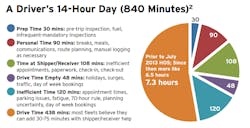Would the 11-hour driving limit for truckers make more sense to shippers and receivers if that time could be translated into value, into real-world miles, into dollars and cents? That’s the approach taken in a recent white paper, “660 Minutes: How Improving Driver Efficiency Increases Capacity,” from J.B. Hunt Transport Inc.
The report takes a look at a driver’s day under the hours of service (HOS) rule, intended “to broaden understanding of these often misunderstood regulations.”
“In many ways, capacity shortage and driver inefficiency are a result of misinformation surrounding hours of service,” it reads. “Think of a driver’s time as that of an hourglass, a perishable commodity which is continually diminishing.”
In doing the math, subtracting those 660 minutes of available driving time and a 30-minute mandatory break from the 840 minutes of the duty day leaves 150 minutes of on-duty, not-driving time. But that’s on paper. In reality, according to a study cited in the report, the average driving time at one large fleet has fallen to 390 minutes, a drop of 48 minutes in actual driving time under the 2013 HOS changes.
Other time-consuming activities cited in the study included empty drive time, appointment inflexibility and time spent at the shipper or receiver location. “A loss of minutes, even hours when multiplied over many loads, can create a severe impact on capacity,” the report says.
A pie chart and a timeline illustrate how a driver’s time is spent. And despite having a “favorable” day, the driver in the example forfeited at least two hours he could have spent on the road, the white paper points out.
Those wasted two hours—even with only 3 hours total for pickup and delivery, and another hour looking for a safe place to shut down—works out to 100 lost miles. Figuring 250 work days, that comes to 25,000 lost miles for the driver—and, again, the example is of a “pretty good” day.
More to the point that’s important to shippers, that amounts to 36 missed loads, using a 700-mile length of haul.
Multiply that by the number of long-haul drivers on the road, and that’s some serious capacity being lost to inefficiency.
So how can shippers help? For starters, just taking 30-minutes off of the time a truck spends waiting at each end of a load gives the driver back 12,500 miles per year. In other examples, the white paper notes that drop-and-hook, compared to live unloading, would save 48 minutes a day (worth 10,000 miles per year), while flexible pickup and delivery times would trim 45 minutes a day (9,375 miles). The report also points to the benefits of onsite parking and driver amenities, as well as more efficient delivery plans.
All told, by using the suggested “best practices,” shippers could potentially contribute another 44,375 miles to driver’s annual total, or an additional 63 loads.
“Effectively, this change would have allowed three drivers to pick up and deliver a greater number of loads than every four drivers accomplish today,” the white paper says. “That’s a more than 33% increase in productivity per truck per year—equivalent to at least 25 trucks of additional capacity.”
Along with warning about the impact on capacity of coming regulations such as electronic logging devices, the J.B. Hunt report specifies “some key traits” often considered in evaluating shippers—and suggestions for becoming a “a shipper of choice”:
- Flexibility
- Attentiveness to Driver Hours
- Proactive Communication
- Driver Accommodation
- Load and Lane Consistency
- Expedited Payment Terms
“As the economy begins its recovery and capacity tightens, shippers can create strategic carrier partnerships by treating driver hours as a perishable commodity on a running clock and by taking action to minimize excess time spent off the road,” the white paper concludes.
About the Author
Kevin Jones 1
Editor
Kevin has served as editor-in-chief of Trailer/Body Builders magazine since 2017—just the third editor in the magazine’s 60 years. He is also editorial director for Endeavor Business Media’s Commercial Vehicle group, which includes FleetOwner, Bulk Transporter, Refrigerated Transporter, American Trucker, and Fleet Maintenance magazines and websites.


